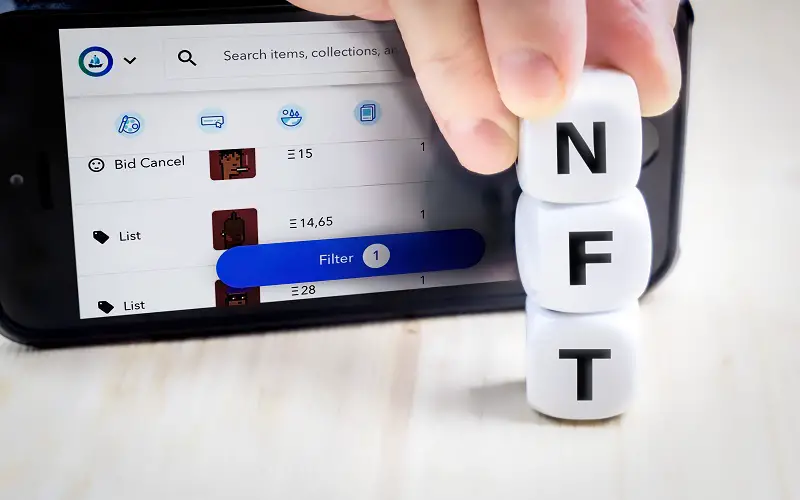Fully known as Non-Fungible tokens, NFTs have taken the world by storm, with thousands of articles talking about them in a relatively short period. If you are looking for more information about these tokens, this is the right website. This particular article will explore NFT trading and furnish you with all the necessary information. We will guide you on making your first money off NFTs and puck the best platform for your undertakings.
NFT Trading
NFT trading has become more popular, partly because it is fuelled by digital artwork, allowing digital artists, designers, and photographers to make some money off their work. However, it also recognizes music, game characters, sports trading cards, and other digital collectibles. Most trades are supported by smart contract technology and recorded on the blockchain, which acts as a digital record holder for transactions. Therefore, if you have any artwork or worthy NFT, it can be purchased in dollars or crypto and entered into the blockchain.
We can’t tell or accurately predict the future of NFT trading. All we know is that the related markets, sites, applications, and platforms are rapidly growing. Before we delve deeper, note that NFTs are different since they have unique forms and values, unlike bitcoins with equal values.
How to Start Trading NFTs
There are different approaches when it comes to trading NFTs. The most common are direct trading, which we will cover in detail in the following paragraphs. All these methods guarantee high-profit margins if done well.
1. Direct Trade
As mentioned above, direct trade is the most accessible means of earning money from non-fungible tokens. It entails buying NFTs and selling them at a profit. This is quite obvious and can be done from the comfort of your chair or bed. You need an application or NFT dedicated marketplace for such an operation. (Refer to our previous articles reviewing some of the best NFT platforms and marketplaces for enthusiasts, collectors, and investors. )Choose wisely since these markets differ in features and cost.
You will also need a crypto wallet to trade non-fungible tokens directly. Be careful since not all wallets support NFTs. (Like platforms, we have reviewed some of the best crypto wallets for NFT traders in our previous articles) The wallet should be credited with enough crypto to allow you to purchase tokens of choice. Once you have purchased an NFT, the sale must be verified and the transaction recorded on the blockchain before being available in your wallet.
You can choose to hold and sell this token later when the market is booming by auctioning it for a better price. These acquisitions will also give you a chance to build your gallery if you are a collector.
2. Investing in and Later Trading Crypto Tokens
You can also choose to indirectly invest in the NFT industry if you do not want to trade at the moment. Every marketplace has tokens that increase in value as time goes by and markets grow. Popular options include MANA for Decentraland, SAND for Sandbox, and AXS for Axie Infinity. They can be traded or exchanged for additional in-game purchases or crypto.
Note that you can also trade cryptocurrencies that increase in value as time goes by. This is the best alternative to direct trading as it allows you to grow your tokens, which you can quickly earn through gaming.
3. Creating Your Own NFTs and Selling
The third and most exhaustive method is to mint your own NFTs and sell them. You don’t need any technical knowledge to create your own NFTs; only some time and creativity. Even though the conversion part can take a significant toll on you, it is manageable if done right.
Most NFT compatible blockchains have templates, which you will need for this process. Most NFTs on sale are made with ERC-721, belonging to Ethereum, while semi-fungible concert tickets and select game items are made with the ERC-1155 protocol. Also, note that these platforms have the EIP-2309, which permits miners to mint all the tokens they need in a transaction. Such knowledge will come in handy when creating your NFTs.
a) How to Sell NFTs
Now that we’ve mentioned NFT creation and sale, we will guide you on the processes required to make some money. Keep in mind that you have to stamp your NFT to prove authenticity. Here is a detailed step leading to the stamping and sale.
Set Up a Digital Wallet
You will need a digital wallet with enough cryptocurrency for purchasing, selling, and minting NFTs. However, some platforms are gasless, meaning that you do not have to pay any minting fees when creating NFTs, even though you will still need the wallet to receive payment once it is sold. Remember that you can securely sign in and create an account with any NFT marketplaces once you have a wallet.
If your blockchain does not support gasless minting, buy enough crypto for stamping your first NFT. This is a pretty straightforward process. All you need to do is buy the proper crypto based on the blockchain of your NFT creation platform.
Connect Your Wallet to a Marketplace
You have several options when it comes to NFT Marketplaces. For beginners, we recommend OpenSea, the oldest NFT marketplace. It has an easy-to-use interface and a load of other advantages. However, be ready to incur high gas fees since it is based on the Ethereum Blockchain.
Anyway, once you have your wallet stocked with enough capital, the next step is to link it to the right marketplace. Most platforms only need a QR code, and you will be good to go.
Create an Advanced Workmanship Record
Remember that you can convert any document design supported by your NFT marketplace into an NFT in a relatively easier process that shouldn’t take long.
Make Your First Posting
After converting your piece to a non-fungible token, the next logical step is to post it on your preferred marketplace and commence the selling process. Most platforms have a create button on the screen, which you can tap for this process.
You will be allowed to stamp your work either as an original unique piece or a combination of several things. Naming and pricing come afterward. Platforms running on the ETH blockchains will quote the number of ETHs required to mint the NFT, a value popularly known as the gas fees. Note that the token will only go live once this is paid. If you are wondering why you need to pay a fee to mint NFTs, it compensates for the energy and exertion used in the process.
Some platforms will allow you to choose a one-time sale or an auction. The latter guarantees you more profit.
4. Receiving Offers
Anybody browsing through your platform can make a bid and buy your token once it goes live. You can close the sale once you get an offer that impresses you.
These three methods are the best and safest ways of making money from NFTs. Alternatively, you can create an NFT portfolio before selling individual pieces later on select platforms. Remember, some NFTs are sold as a collection, and therefore, take some time to assess what you want before beginning the minting process.
Also, platforms such as Flow have no gas fees thanks to their gasless minting capability, saving you money. The only disadvantage is that most marketplaces running on such blockchains are not as popular as OpenSea, and therefore, you may not sell your NFT as fast as you may think.
NFT Trading Platforms
NFT Trading Platforms, popularly known as NFT marketplaces, are the applications or forums that connect you to buyers or sellers. You can buy or sell any provided digital asset. Compare them to digital art online stores.
How to Choose The Right Platform
We will furnish you with everything you need to know when choosing an NFT marketplace to help you get the best results off your trades. Settling for the best marketplace goes beyond picking any random platform that can connect you to potential buyers. You should ask yourself several questions, which include:
1. The Blockchain Used
There are several blockchains supporting NFTs creation and sale. Developers and big tech companies keep coming up with options targeting different users, a highly beneficial trend. Your marketplace’s blockchain determines several things, but mostly the transaction fees.
Sites such as OpenSea use Ethereum, which has been constantly criticized because of its high transaction charges christened gas fees. Luckily, most marketplaces are now resorting to cheaper gas fees options to conserve the environment. Lower gas fees also mean that you will maximize profits, which every trader should attempt.
Note that these platforms differ in their carbon footprints, a phenomenon that is heavily based on the blockchain used. It has been observed that newer blockchains have better carbon footprints, partly because they don’t have as many users. This is a controversial topic that has captured the attention of several industry players and environmental groups that believe that we must do something. The problem existed long before NFT as crypto also relies on blockchain technology, leaving behind profound carbon footprints during minting. Therefore, choose wisely.
2. Transaction Fees
These marketplaces will take a given percentage of your total sales as commission. This is pretty normal since they link you to the buyer by acting as an intermediary and saving you the stress of marketing your NFTs. However, have in mind that they charge different percentages, meaning that you will spend less on some and maximize your profits while incurring more on others.
Whereas some require only 2.5% of the value of your NFT’s selling price, you will incur as high as above 7% on others for your first NFT sale. You don’t get to choose since this fee is deducted before the balance is credited to your wallet. We advise you to choose a platform that charges only a small fee, allowing you to ass more profits on your creation.
3. Type of NFTs
You should also consider the type of NFTs you intend to produce before picking a marketplace. Even though platforms such as OpenSea Dela in a range of NFTs, others are more specific with their target audience and may lock you out if you don’t conduct extensive research beforehand.
Marketplaces such as Autograph, co-founded by Tom Brady, mainly sell celebrity and athletes’ signatures and, therefore, may not be the best for your items. Your choice of the platform must support all the relevant NFTs. This should be your first consideration. Based on their offerings, some of the best marketplaces you can choose for your NFTs are Binance, Open Sea, and Axie marketplace.

Risks and Challenges of NFT Trade
NFT trading is not all that rosy. It comes with several risks and challenges. Most people are increasingly questioning how long this wave will last, knowing very well the potential damage it may have on investors if it ends. Like crypto, collectors have NFTs worth millions of dollars, with some holding them for later profits while others accumulate them for pride. The cheapest NFT profile picture at the moment costs slightly above $500 000, meaning that holders are set to undergo massive losses if the trend dies. NFTs are also harder to exchange since they are fungible, unlike crypto. Even though it presents enormous potential for future growth, the crypto world can be hard to predict with certainty.
However, we are hopeful that NFTs will be here to stay, given that it is an ever-growing trend. Let’s take a look at the following risks and challenges before you venture into NFT ownership and subsequent trading. Note that most threats are caused by a spontaneous change in value and the uncertainty of the ecosystem surrounding NFTs. Here is a comprehensive list:
1. Cyber Security and Fraud
The technological rise witnessed in the last decade has made life easier, albeit at a price. It has created many cybersecurity and fraud risks, which have increasingly grown with the advent of NFTs. NFT store replicas prying on unaware collectors have been reported recently. There have also been incidences of people taking up artists’ identities, especially those yet to join the NFT bandwagon.
The latter means that unsuspecting buyers can interact with impersonators, paying more for pieces that shouldn’t have cost as much. Therefore, you must be vigilant before commencing your NFT trade or risk making losses.
2. Smart Contract Risks
Smart contract technology is a pretty recent invention that promotes decentralized finance and promotes the sale of NFTs. However, it comes with its fair share of risks. In 2021, Poly Network lost over $600 million to hackers. This incident on the DeFi protocol created to offer cross-chain interoperability raised an alarm, making people question if smart contracts were as secure as platforms made them look.
Even though the platform has recovered most of the NFTs, the issue of smart contract security is still significant.
Challenges
Here are some of the challenges associated with NFT trading:
1. IP Rights
This is perhaps the biggest challenge when it comes to these digital assets. Buyers do not automatically receive any IP rights in NFTs and may have to develop specific and elaborate terms and conditions of the particular NFT contract.
Also, it becomes pretty challenging to discover whether a seller owns the NFT before purchase without observing the required due procedure. You can easily end up with NFT replicas thinking you have the best deal. This is a challenge that regulators should look into.
2. Evaluation
The values of NFTs are uncertain and cannot, therefore, be predicted accurately. These tokens are scarce owing to their fungible nature. Their valuation depends on perceptions and distribution channels. You cannot easily establish these two, which is a considerable disadvantage. However, this would be a great chance if you are a risk-taker.
Worthy Strategies
This last part of the article will look at some of the best NFT trading strategies you can resort to.
- Value Strategy
This takes care of highly valuable NFTs such as CryptoPunk. It involves purchasing a rare NFT whose value increases as supply decreases.
- Using Google Trends
You can easily see whether an NFT is worth your time through Google Trends. You will also obtain the evolution of public opinion regarding the token. A high rating indicates several collectors, hence viable for purchase.
- Only Buy Assets with Fewer Sellers
You will struggle to sell an NFT if you pick one with several sellers unless you lower your price. Consider whether the listed prices are higher than recent sales or not.
- Buying the Ceiling or Floor
You can choose to buy an NFT at their floor price and hold them for some time. You will earn more if it grows.
Buying the ceiling targets exclusive and expensive NFTs in high demand. These tokens lockout several collectors owing to the price increasing their rareness.
Conclusion
NFT trading is a reliable way of making some extra money. However, make sure that you conduct adequate research since it requires preparation just like any other investment. Lastly, consider a trading strategy that will work for you.




